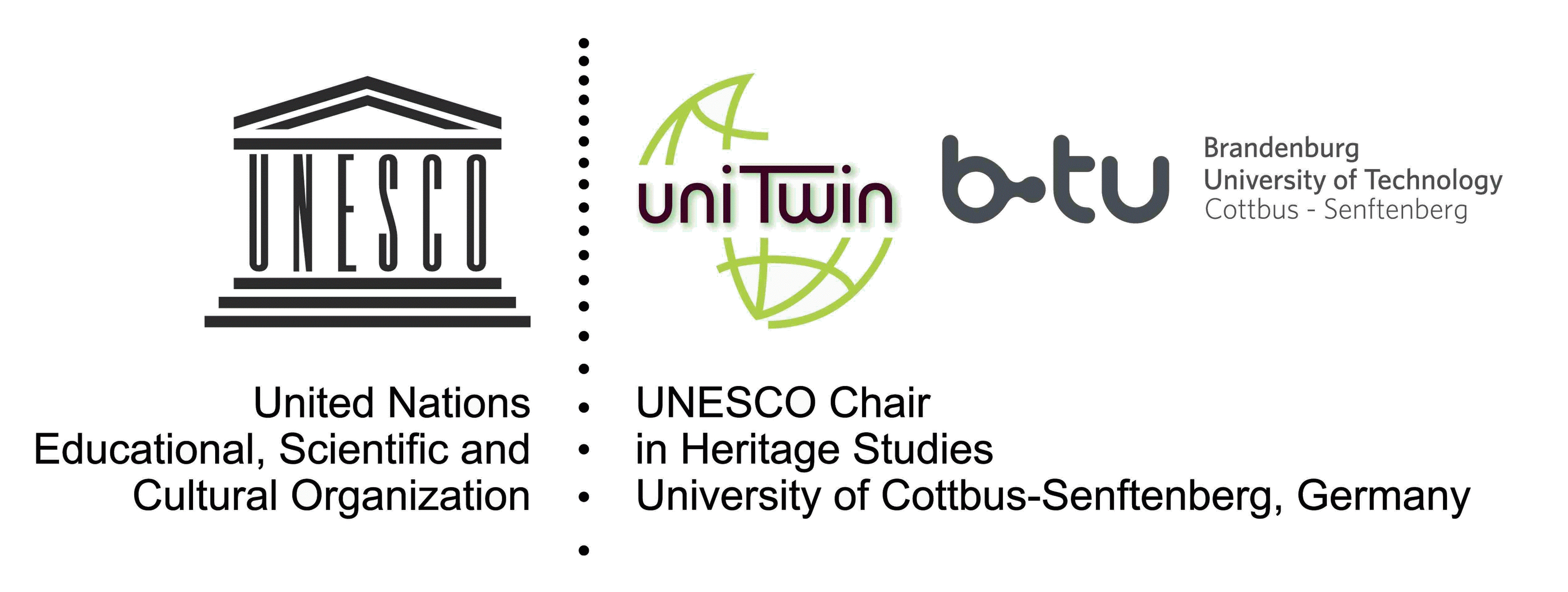
Die Internationale Akademie war die vierte von insgesamt fünf konsekutiven interdisziplinären Sommer-Akademien (ISAC) an der BTU Cottbus-Senftenberg. Sie wurde vom 30.11. 2015 bis zum 12.12.2015 im Rahmen des PhD-Programms Heritage Studies an der BTU Cottbus-Senftenberg durchgeführt.
Das zentrale Thema dieser Akademie behandelte das breite Konfliktfeld, dem das Erbe der Menschen zunehmend ausgesetzt ist und für das disziplinäre und interdisziplinäre Lösungsstrategien identifiziert bzw entwickelt wurden. Die ISAC 2015 zielte damit auf die Weiterentwicklung von nachhaltigen Schutz- und Nutzungskonzepten von Erbe im Sinne der UNESCO-Konventionen und auf die Rolle und Bedeutung von Erbe für nachhaltige und menschliche Entwicklung.
Die übergreifenden Themen Konflikte und Konfliktlösungsstrategien wurden dabei in fünf Themenbereiche unterteilt:
(Nur in Englisch verfügbar.)
![By Bernard Gagnon (Own work) [GFDL (http://www.gnu.org/copyleft/fdl.html) or CC BY-SA 4.0-3.0-2.5-2.0-1.0 (http://creativecommons.org/licenses/by-sa/4.0-3.0-2.5-2.0-1.0)], via Wikimedia Commons](https://heritagestudies.eu/wp-content/uploads/2015/11/1024px-Palmyra_01-1024x764.jpg)
The Decumanus Maximus on the site of Palmyra, Syria; By Bernard Gagnon is icensed under GFDL and CC BY-SA 4.0–3.0–2.5–2.0–1.0 via Wikimedia Commons
Heritage in the Event of War and Terrorism
As more sites become threatened with destruction, heritage professionals, institutions and government bodies play an increasingly important role in protecting both the built and intangible heritage. Heritage sites, traditional knowledge and skills, language and music all serve to represent not only the history of a community, but also its identity. The freedom to practice our own self-identified heritage is not only an essential component of international human rights, but it also a key to the sustainability of a culture. Unfortunately, it is the aim of groups such as ISIS and other illegal armed groups, to destroy all traces of cultures that are not their own by completely wiping their heritage and thus the different histories off of the map. The current discourse concerning heritage in armed conflict zones is focused mainly on re-building after demolition and/or 3-D documentation, so that destroyed heritage is not lost forever. Looking to the future, as the sole UN agency whose mandate it is to protect cultural property and heritage, it is vital that UNESCO devises pro-active steps that can be acted upon before destruction.
Further reading:
Nsengimana, D. 2011. Youth Friendly Conflict Resolution Tools for Community Intervention. [online]
Available at: www.ziviler-friedensdienst.org/sites/ziviler-friedensdienst.org/files/anhang/publikation/zfd-youth-friendly-conflict-resolution-tools-community-interventions-1494.pdf
Sinclair, M. 2004. Learning to Live Together: Building Skills, Values and Attitudes for the Twenty-First Century. France, UNESCO. [online] Available at: www.developmenteducation.ie/teachers-and-educators/transition-year/strand-3-Conflict/Resources/Learning_to_Live_Together.pdf.
UN. 2008. United Nations Youth. Definition of Youth Fact Sheet. [online] Available at: www.un.org/esa/socdev/documents/youth/fact-sheets/youth-definition.pdf
War Child. 2011. Youth and Conflict. Youth Working Group Briefing Paper. [online] Available at: www.warchild.org.uk/sites/default/files/Youth%20and%20Conflict%20Brief%20-%20IYY.pdf
Williams, R. 1960. Border Country. Parthian Books.
Women’s Commission for Refugee Women & Children. 2000. Untapped Potential: Adolescents affected by armed conflict.
![Waldschlößchenbrücke 2013 Dresden; By Dr. Bernd Gross (Own work) [CC BY-SA 3.0 (http://creativecommons.org/licenses/by-sa/3.0)], via Wikimedia Commons](https://heritagestudies.eu/wp-content/uploads/2015/11/1024px-Waldschlößchenbrücke_2013_Dresden_001-1024x230.jpg)
Waldschlößchenbrücke 2013 Dresden; By Dr. Bernd Gross is licensed under CC BY-SA 3.0 via Wikimedia Commons
Heritage Impact Assessment (HIA) as a tool for solving conflicts
The discussions in these thematic areas emphasised the need for further study and improvement of Heritage Impact Assessment as a new tool in order to effectively respond to the problems resulting from conflicts between development and protection of cultural heritage. Still, this tool needs to be integrated into the management and conservation strategies of World Heritage Sites. An appropriate HIA can improve the resilience of tangible and intangible heritage in the face of future development. An important issue, which is often neglected, is to consider local community and encourage participatory methods in the application of HIA where it can positively rebind local communities with their values. In addition, further effort is required to support HIA by local administrations and state parties through the development of legal mandates for the implementation of HIA in heritage protection actions.
Further reading:
UNESCO. 1972. Convention Concerning the Protection of the World Cultural and Natural Heritage. The World Heritage Convention
Sagnia, B. K. 2004. Framework for Cultural Impact Assessment. International Network for Cultural Diversity (INCD); Cultural Impact Assessment Project. Dakar, Senegal.
ICOMOS. 2011. Guidance on Heritage Impact Assessments for Cultural World Heritage Properties.
Kloos, M. 2015. Heritage Impact Assessments as a Tool to Open Up Perspectives for Sustainability: Three Case Studies Related to Discussions Concerning the Visual Integrity of World Heritage Cultural
![By المصور أنس الحاج (Sana'a - HDR) [CC BY-SA 2.0 (http://creativecommons.org/licenses/by-sa/2.0)], via Wikimedia Commons](https://heritagestudies.eu/wp-content/uploads/2015/11/Sanaa_HDR_16482367935-1024x632.jpg)
Sana’a – HDR by AnasALhajj.Photography المصور أنس الحاج is licenced under CC BY-SA 2.0 via Wikimedia Commons
Historic Urban Landscape Approach
The Historic Urban Landscapes Declaration was adopted by UNESCO in 2011 in order to address contemporary issues related to heritage in historic urban contexts. This approach aims to increase the sustainability of urban development by integrating the environmental, social and cultural concerns into the planning of heritage in historic urban landscapes. The approach has had very positive outcomes when it comes to the creation of a balance between development and protection of urban heritage. However, some concerns have arisen in relation to authenticity and integrity, and this has evidenced the need for integrated strategies to achieve the sustainable development of urban contexts and solve the conflict between these interrelationships. Therefore, professionals call for a comprehensive and integrated approach for the identification, assessment, conservation and management of these historic urban landscapes that takes into account urban values and identity, as well as a holistic landscape approach that integrates urban conservation into the wider socio-economic development.
Further reading:
UNESCO. 2011. Recommendation on the Historic Urban Landscape adopted by the General Conference at its 36th session. Paris.
UNESCO. 2011. Recommendation on the Historic Urban Landscape adopted by the General Conference at its 36th session. Paris, France. [online] Available at: https://unesdoc.unesco.org/images/0021/002110/211094e.pdf
Durham University. 2012. Researching the Historic Urban Landscape: The Challenges of the Secular, Religious and Historic Urban Environment. Durham, UK.
UNESCO. 2013. New life for historic cities: The historic urban landscape approach explained. Published by the United Nations Educational, Scientific and Cultural Organization (UNESCO) Paris, France.
Veldpaus, L. and Pereira Roders, A. 2013. Historic Urban Landscapes: An Assessment Framework. ‚IAIA13 Conference Proceedings‘: Impact Assessment the Next Generation, 33rd Annual Meeting of the International Association for Impact Assessment, Canada.

Boulder Glacier – Terminus – 1913 Glacier National Park, Montana. Boulder Glacier, viewed from the lava bed, looking west. Small boulder moraine. The second lava bed is near the upper margin of the ice on the left. August 5, 1913. USGS Photographic Library #awc00701
Climate Change and Natural Disaster as Challenges for Natural Heritage
Climate change, “a change in the climate that persists for decades or longer, arising from either natural causes or human activity” (UNISDR, 2009, p. 7), is a serious global challenge, particularly in a world of exponentially growing population and development, hurrying to keep pace. As it is a process that affects our environment, it also has an impact on our natural and cultural heritage. The current trend in dealing with the enormous, global issue of climate change on a local scale has been to turn from prevention to adaptation, focusing for example on fostering ecosystem resilience and site-specific climate change adaptation strategies. If one takes a look at recent natural and mixed World Heritage nominations, it is evident that (at least at that stage) management has not prepared specific, actionable strategies for what is projected to become the greatest threat to these sites. Although some climate change occurs naturally, in recent times humans have accelerated the process to the point of great concern. Even if emissions were completely halted, climate change would continue to impact natural heritage in the future. Because climate change is a global and local issue, it requires global and local solutions. One important aspect of addressing the challenge of climate change is awareness raising; therefore it becomes crucial for cultural heritage professionals to understand how climate change crosscuts many sectors.
Further reading:
Colette, A. (ed.). 2007. Climate Change and World Heritage: Report on predicting and managing the impacts of climate change on World Heritage and Strategy to assist States Parties to implement appropriate management responses. Paris: UNESCO World Heritage Centre.
Intergovernmental Panel on Climate Change. 2014. Climate Change 2014: Synthesis Report. Contribution of Working Groups I, II and III to the Fifth Assessment Report of the Intergovernmental Panel on Climate Change [Core Writing Team, R.K. Pachauri and L.A. Meyer (eds.)]. Geneva: IPCC, 151 pp.
International Union for Conservation of Nature. 2015. Climate change and dams threaten natural World Heritage, warns IUCN [online] 25 June. Available at: http://www.iucn.org/?uNewsID=21573 [Accessed 10 November 2015].
United Nations International Strategy for Disaster Reduction. 2009. 2009 UNISDR Terminology on Disaster Risk Reduction. Geneva: UNISDR.

Palestine, Land of Olives and Vines. “Abu Jaber surveys his land #2” by Michael Loadenthal is licensed under CC BY-NC-SA 2.0 via flickr.com.
Cultural Landscapes in Conflict: Challenges and Solutions
The constant evolution and change of cultural landscapes, which is in some cases seen as a threat, could also be an opportunity to reflect upon the importance and meaning of cultural landscapes in our contemporary societies. In this sense, the current discourse focuses on the need to re-define a more suitable approach to preserve and manage cultural landscapes, which takes into account different perspectives and new views on conservation and preservation, land use, human interaction and site conservation. Furthermore, the different management strategies to approach its issues need to consider the changes and its natural evolution, as well as relevant aspects like environmental concerns, the preservation of cultural values, the meaning and interpretation and the interests of local communities, indigenous populations and other stakeholders, whose views on the site could be conflicting.
Further reading:
UNESCO. 1972. Convention Concerning the Protection of the World Cultural and Natural Heritage – World Heritage Convention
UNESCO. 1994. Operational Guidelines for the Implementation of the World Heritage Convention. [online] Available at: https://whc.unesco.org/archive/opguide94.pdf
Antrop, M. 2005. Why landscapes of the past are important for the future. In Landscape and Urban Planning. V. 70, Issues 1-2.
Antrop, M. 2006. Sustainable Landscapes: contradiction, fiction or utopia? In Landscapes and Sustainability. V. 70, Issues 3-4
IUCN World Commission on Protected Areas, IUCN. 2005. The Protected Landscape Approach: Linking Nature, Culture and Community. Glandand Cambridge
Stephenson, J. 2006. Conflict in the Landscape: A Case Study of the Cultural Values Model. In Public Historic Review. V 11
Taylor, K. 2012. Landscapes and Memory: cultural landscapes, intangible values and some thoughts on Asia. The Australian National University
PDF zum Ansehen oder Download:
Conflict Solving Strategies (en)
Welcome Prof. Dr. Marie-Theres Albert ISAC2015 (en)
Präsentation ISAC 2015
Programme ISAC 2015 (en)
Sachbericht ISAC 2015
Besuchen Sie die ISAC Website: International Academy Cottbus
Organization:
Support by:
Under the patronage of:
- Unser WeltErbe – Die montane Kulturlandschaft Erzgebirge/Krušnohoři
- Grenzübergreifendes europäisches Welterbe – ein Thema für UNESCO Projektschulen
- Afrikanisches Kulturerbe und die Säulen der Nachhaltigkeit
- Symposium: „Die 4 Säulen von Nachhaltigkeit“
- Symposium: „Schritte zur Umsetzung der Global Strategy in Deutschland“
- Welterbe und kulturelle Vielfalt in Theorie und pädagogischer Praxis
- Erforschung, Bewertung und Bewahrung der Friedenskirche in Jawor als Weltkulturerbe (2011-2014)
- Internationales Forschungsprojekt: „Cultural Capital Counts (CCC)“ (2011-2014)
- Wissensquiz zum UNESCO-Welterbe Montanregion Erzgebirge/Krušnohoří




Sie müssen angemeldet sein, um einen Kommentar zu veröffentlichen.